The scars we’ve etched upon the Earth are a stark reminder of our disconnect from the natural world. From fragmented landscapes, depleted wildlife populations, and disrupted natural processes, it is time we don’t look the other way and help preserve what little is left before it is too late. How can we do this you may ask?; well the answer is; rewilding. Rewilding is a revolutionary approach to conservation that offers a glimmer of hope. It is a call to action that urges us to actively restore entire ecosystems, allowing nature to heal itself and reclaim its lost wildness. In recent decades, habitat loss, human exploitation, and climate change threaten one million animals and plant species with extinction over the coming decades. Melting glaciers in the Arctic, the drying out of peatlands caused by hotter weather, damage caused by increasing floods, fires and droughts and “unsustainable agricultural systems” are among the threats damaging nature. In Europe alone, more than 80% of land is degraded and less than 30% of rivers are regarded as healthy (1) . Through rewilding, we can dismantle human interventions that have choked natural processes, reintroducing missing keystone species, and ultimately, letting nature reassert its dominance. Envision forests, once fragmented by human activity, regenerate naturally, teeming with life, from the canopy dwellers to the detritivores hidden amongst the fallen leaves. Vast interconnected landscapes with herds of herbivores roaming, grazing patterns creating a mosaic of meadows, woodlands, and wetlands. This is the essence of rewilding. In recent years, a Rewilding project in Europe has aimed to envision the essence of Rewilding in a mosaic landscape between Romania and Ukraine where the natural ecosystem was at equilibrium but now is full of instability, and that is The Danube Delta.
The story of the Danube Delta, a sprawling wetland paradise nestled in Eastern Europe, serves as a powerful testament to the transformative power of rewilding. Once heavily impacted by human activities like dam construction and intensive agriculture, the Delta’s delicate ecological balance was severely disrupted. However, in recent decades, a remarkable rewilding effort has been underway, offering a glimpse into a future teeming with life. In 2019, Rewilding Europe announced the re-introduction of the water Buffalo to Ermakov island after being absent for centuries. When humans first arrived to Africa and Europe some 45,000 years ago, they encountered a fauna wholly different from today; Bubalus Murrensis, also known as the water buffalo. These animals lived near Europe’s major rivers but vanished sometime in the late Pleistocene or early Holocene. Whether they were killed off by overhunting from incredibly lethal new arrivals-Homo Sapiens– or climatic environmental changes, we simply don’t know (2). But the 2019 Rewilding Europe Project is continuing its effort to re-introduce a similar water buffalo species to the Delta that will carry the same biological functions in the ecosystem as Bubalus Murrensis once did.
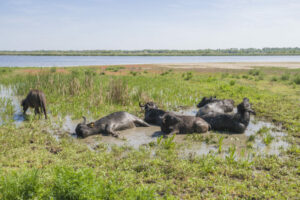
In May, 2019, a herd consisting of five males and two females originating from a small farm in Transcarpathia was successfully released into the 3500 hectare island of Ermakov. This introduction would help create a dynamic landscape, benefiting an array of wildlife, such as birds, amphibians, insects, and fish. Water buffalo are well suited to the environment in the Danube delta, adapting better to wet conditions and poor quality vegetation than cattle, while having the same positive effect on flora and fauna diversity that other grazers have (2). Water buffalo are known for their fondness for wallowing in shallow water bodies (Figure 1). This seemingly simple act has a profound ecological impact. The wallows they create become vital breeding grounds for amphibians like frogs and toads, which rely on these shallow, still waters to lay their eggs. Additionally, the buffalo’s churning hooves disturb the soil as they graze. This may seem disruptive, but it actually benefits the ecosystem in several ways. It helps in the dispersal of plant seeds, allowing them to reach new areas and establish themselves. Furthermore, the churning action breaks down organic matter like leaves and dead plant material, which decomposes and enriches the soil, making it more fertile for new plant growth. As the visual benefits of the introduction of the water buffalo to Ermakov island proved victorious, several weeks later, the natural grazing of Ermakov Island was given a boost with the arrival 10 more water buffalo from the same farm in Transcarpathia.
The story doesn’t end there. The Danube Delta’s rewilding is not just about bringing back charismatic megafauna; it’s about restoring a complex web of life. Another successful rewilding project involves the Dalmatian pelican, one of the largest birds in the world, with a wingspan of almost three meters and weight of over 10 kg (3) These avian giants had vanished from the Delta entirely, a stark reminder of the ecosystem’s decline. But thanks to rewilding efforts, pelicans are taking flight once more. Their return signifies a healthier ecosystem with abundant fish populations, a vital indicator of a revitalized ecosystem and serves as a powerful testament to the success of rewilding efforts in restoring balance to this critical wetland habitat.
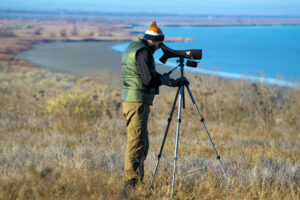
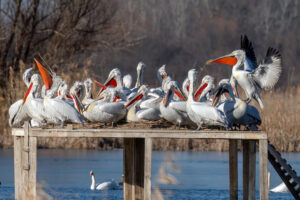
Coordinated by Rewilding Europe, the Pelican Way of Life Initiative kicked off in late 2019, with the aim of enhancing the populations of the Dalmatian pelican in southwest Europe – including in the Danube Delta, one of the strongholds of the species. The Dalmatian pelican is extremely vulnerable wherever it is found. This bird is included in the IUCN red list in the category “Near Threatened”, as well as in the Red Book of Ukraine. In recent decades, the global population of the species has suffered drastic declines due to collisions with power lines, habitat loss, disturbance, bird flu, persecution by fishermen, and a lack of awareness among local communities. During the penultimate week of 2022, the staff of the Danube Biosphere Reserve (DBR) visited the Danube delta in search of Dalmatian pelicans. In Ukraine the counts took place as part of the “Pelican Way of Life” project being implemented in the country by Rewilding Ukraine in cooperation with the DBR (Figure 2). In total scientists counted 119 Dalmatian pelicans, most of which were observed in the Lake Cahul(4). In general there has been a positive trend in the population of the Dalmatian Pelican species and that can be attributed to the rewilding efforts within the region. Dalmatian pelicans, once a majestic presence in the Danube delta, vanished due to habitat degradation and dwindling fish populations. To coax them back and restore the ecological balance, rewilding efforts incorporated a clever strategy; artificial breeding nests. These are not elaborate structures. They are typically large, sturdy platforms built from wood or other materials that are strategically positioned on the Delta’s waterways, helping the Dalmatian pelicans find interest on the platforms (Figure 3). Dalmatian pelicans prefer to nests on small nests on small islands or natural platforms in shallow waters. Human activity and habitat loss have eliminated these natural nesting sites. Artificial sites have provided a suitable alternative, playing a crucial role in shielding the pelicans from potential predators and disturbances. By ensuring undisturbed nesting of the pelicans is vital, given their susceptibility to disruptions. The newly constructed platform serves as an isolated island surrounded by water, replicating the natural conditions of these (5) Additionally providing a stable, elevated platforms helps reduce the chances of eggs or chicks being washed away by high water levels. This translates to a higher chick survival rate, a crucial factor for population growth. Since the last time the Dalmatian population was counted in 2019, Dalmatian pelican numbers have increased in the Romanian part of the delta to an estimated 446-486 pelicans in 2020 (6), demonstrating the positive impacts breeding platforms and other efforts have had on the growing Dalmatian population.
The return of Dalmatian pelicans to the Danube Delta is undoubtedly a cause for celebration. Their presence signifies a healthier ecosystem with a thriving fish population. However, their resurgence isn’t without its challenges for local communities. While the pelicans return is glorious for the ecosystem, it can introduce the element of competition within the area. Local fishermen who rely on the same fish for their livelihood could face economic hardship following the re-population of the Dalmatian Pelican in the Danube Delta. Fishermen see the birds as competition, with some resorting to killing the pelicans in order to prevent them from consuming the fish in the local area (7), halting on going rewilding efforts in the Region. Finding a sustainable balance between the needs of pelicans and humans is crucial for the long-term success of the project. This might involve exploring alternative fishing techniques, establishing quotas, or even implementing compensation programs to support affected communities.
When it comes to the water buffalo, they are large herbivores with a significant appetite. Unmanaged grazing can lead to the overgrazing in certain areas. This disrupts the delicate balance meaning their return can lead to competition with local livestock for grazing land and water resources. This is particularly challenging for small scales farmers who depend on these resources for their livelihood.The reintroduction efforts in the Danube Delta represent a commendable pursuit of a healthier ecosystem. However, acknowledging the challenges and fostering collaboration are crucial to finding a sustainable balance between the needs of Water Buffalo and humans, as it is crucial for the long-term success of the project. A number of steps are critical to find this balance. First, community engagement; open communication and ongoing engagement with local communities are essential. Understanding their concerns and incorporating them into the project fosters a sense of ownership. Communities can be involved in monitoring efforts, eco-tourism initiatives, or even buffalo herd management. Second, sustainable management; careful planning and responsible management are key. Regularly monitoring buffalo grazing patterns and pelican populations allows for adjustments to minimize environmental impact. Sustainable fishing practices are essential to ensure a healthy balance for both pelicans and fishers. Last but not least, scientific research; continued research is crucial. Studying the impact of both species on the ecosystem allows for proactive mitigation of potential problems. Additionally, research into alternative income sources for local communities can minimize economic strain. The Danube Delta’s rewilding is a complex endeavor. While the return of water buffalo and Dalmatian pelicans is a positive sign, it necessitates a delicate balancing act. By acknowledging the challenges, implementing responsible management strategies, and involving local communities, this project can pave the way for a future where a thriving ecosystem and the well-being of local people can co-exist.
Rewilding offers a powerful tool for restoring the ecological tapestry that human activity has frayed. By reintroducing missing keystone species and allowing natural processes to take hold, we can breathe new life into damaged ecosystems. These revitalized ecosystems offer a multitude of benefits, from improved water quality and flood control to increased biodiversity and a more resilient environment in the face of climate change. Rewilding isn’t just about restoring the past; it’s about creating a future where humans and nature can thrive in harmony. The Danube Delta’s rewilding efforts serve as a powerful case study, offering valuable lessons that can be applied worldwide. The challenges encountered with water buffalo and Dalmatian pelicans highlight the importance of meticulous planning and ongoing management. Community engagement is paramount – fostering a sense of ownership amongst local communities through education, involvement in monitoring programs, or even eco-tourism initiatives ensures their long-term support. Additionally, the importance of scientific research cannot be overstated. Studying the impact of reintroduced species on the ecosystem allows for proactive mitigation of potential problems, like competition for resources or unintended ecological disruptions. By learning from the Danube Delta’s successes and failures, future rewilding projects can be tailored to specific local contexts. From restoring crucial corridors for wildlife migration in fragmented landscapes to reintroducing apex predators to control invasive species, the possibilities are vast. Rewilding isn’t just about restoring the past; it’s about creating a future where vibrant ecosystems and human well-being are inextricably linked. As we embark on this journey of ecological restoration, the Danube Delta stands as a beacon of hope, demonstrating that rewilding can not only heal the Earth but also forge a path toward a more sustainable future for all.
1.World Economy Forum, 2022, Rewilding: letting nature do it’s own thing, [accessed 2024 April 16], https://www.weforum.org/agenda/2022/10/what-is-rewilding-nature/
2.Hance Jeremy, 2019, Why is Europe Rewilding with water Buffalo?, Mongabay, [accessed 2024 April 14], https://news.mongabay.com/2019/10/why-is-europe-rewilding-with-water-buffalo
3.Cambridge Conservation Initiative, 2019, Water Buffalo release in the Danube delta provides boost for Landscape, [accessed 2024 April 14], https://www.endangeredlandscapes.org/water-buffalo-release-in-the-danube-delta-provides-boost-for-landscape
4. Rewilding Europe, 2022, More and more Dalmatian pelicans choose the Danube Delta for Wintering, [accessed 2024 April 16], https://rewilding-danube-delta.com/news/more-and-more-dalmatian-pelicans-choose-the-danube-delta-for-wintering/
5.Rewilding Europe, 2022, More and more Dalmatian pelicans choose the Danube Delta for wintering, [accessed 2024 April 14], https://stmuscholars.org/rewilding-north-america-the-disconnect-between-policies-and-nature-and-why-its-destructive
6. Pelican Way of Life, 2023, New Breeding platform for pelicans in Persine Nature Park, [accessed 2024 April 16], https://life-pelicans.com/news/new-breeding-platform-for-pelicans-in-persina-nature-park/#:~:text=The%20use%20of%20artificial%20islands,from%20potential%20predators%20and%20disturbances.
7.Rewilding Europe, 2021, Turning the tide for the Dalmatian Pelican, [accessed 2024 April 16], https://rewildingeurope.com/blog/turning-the-tide-for-the-dalmatian-pelican/
8.PBS, 2020, Europe’s New Wild, [accessed 2024 April 14], https://www.pbs.org/show/europes-new-wild
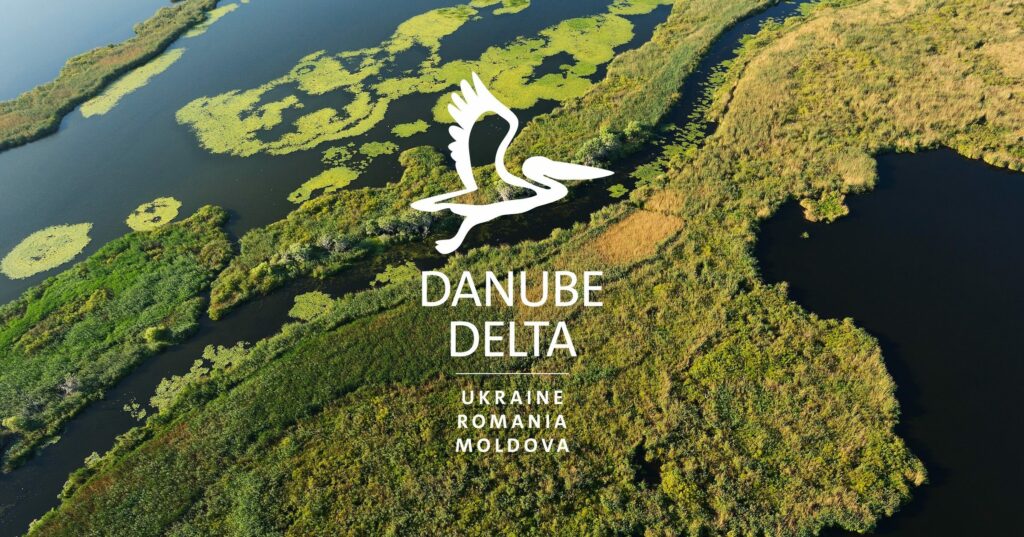
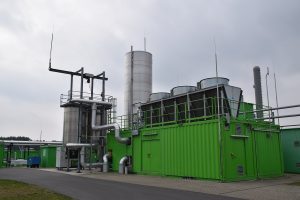
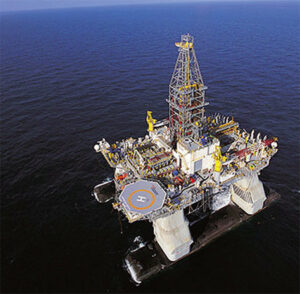
2 comments
Mariana Chamorro
Antonio, your publication on rewilding in the Danube Delta is fantastic! I love how you explain the importance of bringing back animals like water buffalo and Dalmatian pelicans to restore the ecosystem. Your writing is clear and engaging, making it easy to understand the benefits of these rewilding efforts. Keep up the great work !
Rhys Williams
I thoroughly enjoyed delving into the concept of rewilding and its potential to restore ecosystems and preserve biodiversity. The quote emphasizing the urgent need for action to address habitat loss, human exploitation, and climate change resonates deeply, highlighting the critical role rewilding plays in reversing environmental degradation. The vision of interconnected landscapes teeming with life, as exemplified by the Danube Delta rewilding project, offers hope for a future where nature can thrive once again.